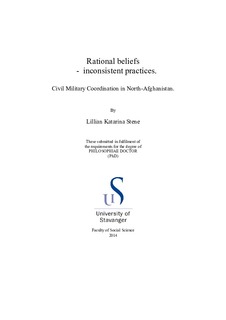| dc.description.abstract | What was the idea?
Coordination is a vital element of crisis management (Turner, 1978; Minear et al., 1992; Schneider, 1995; Rasmussen, 1997; Strand, 2003; Boin et al., 2005; Kruke and Olsen, 2005; Keen, 2008). The coordination between civil and military actors is especially crucial and complicated if the crisis is characterized by political (military), economic, and social conflict, as displayed in Afghanistan.
Civil and military actors have different organizational cultures, standard operating procedures, aims and priorities. Still, they are often forced to coordinate in order to perform their humanitarian, political and military tasks in joint efforts to assist the local populations in a complex emergency.
To manage this coordination, the International Security Assistance Force (ISAF) in North-Afghanistan operated under three concepts: the Comprehensive Approach (CA), Counterinsurgency (COIN), and the NATO civil-military coordination (CIMIC) doctrine. These three approaches, to some extent, overlapped, to some extent were contradictory, but most important; they were differently understood and implemented with various levels of success.
ISAF, as a powerful military actor in Afghanistan, consists of many high qualified and capable soldiers at all levels. The question is whether it is possible for such an organization as ISAF to handle crisis management under the guidance of these coordination concepts and the broad mandates operational in Afghanistan?
To enlighten this, the structures and processes in ISAF organization are studied in order to assess how these structures/ processes influenced the civil military coordination in the field. With the aim of contributing to the enhanced knowledge about civil military coordination, I put forth the following research question:
- How do ISAF structures and processes influence civil military coordination in North Afghanistan?
In the analysis I have applied theories of security and the new wars, complex emergencies and, in particular, organizational theories with a basis in bureaucracy-theory and new-institutional perspectives. The rationale behind this choice was that military organizations are normally viewed as representatives of rational bureaucratic organizations, having structures and processes that characterize rational organizations (Weber, 1971; Banfield, 1959; Lindblom, 1959). The new-institutional perspective is meant to be a tool to explain the shortcomings of rationally built organizations and the influence of the surrounding environment (Greenwood et al., 2008; Meyer and Rowan, 1977; DiMaggio and Powell, 1983). Further, the use of Turner (1976/1978) and Turner and Pigeon’s (1997) theories of man-made disasters enlighten the crisis management perspective.
[...] | nb_NO |

